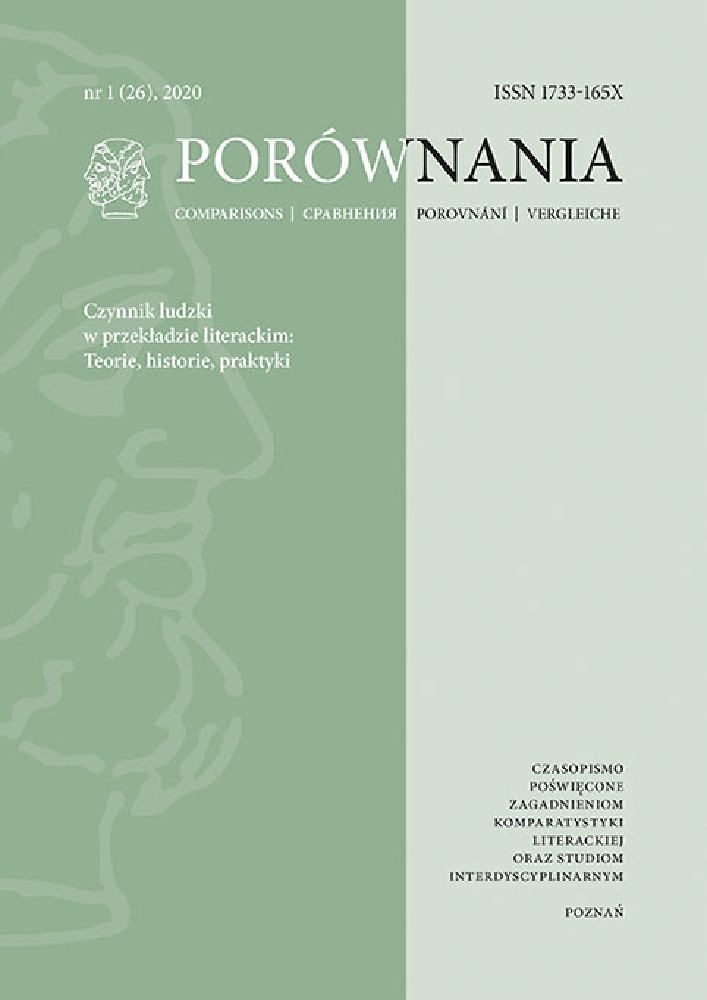Abstrakt
Przewrotna jest rola postępu – im więcej technologicznego rozwoju, tym większy udział człowieka – w koncepcji, formułowaniu zadań, interpretacji wyników, nadzorze i korekcie. Hierarchia jest zachowana, człowiek wciąż nieodzowny, ale to nie znaczy, że w pewnych obszarach maszynowy potencjał rzeczywiście nie przewyższa ludzkiego i że nie warto z tej przewagi skorzystać. Przetwarzanie języka naturalnego (NLP) to dziedzina niemłoda, ale w ostatnich latach dzięki rozkwitowi metod uczenia głębokiego (deep learning), mody na maszynowe wnioskowanie (data/knowledge mining) czy nowym sprzętowym interfejsom (m.in. zaawansowane rozpoznawanie obrazu) komputerowa analiza tekstu przeżywa istny renesans. W odniesieniu do translacji przyjęło się mówić i pisać głównie o coraz doskonalszych lub właśnie zupełnie niemożliwych algorytmach dla kolejnych par języków czy coraz większej precyzji samego tłumaczenia. Niniejszy artykuł przedstawia natomiast nieco szersze spektrum procesu tłumaczenia i przygląda się elementom przekładowi towarzyszącym (jak choćby krytyka), w których wykorzystanie metod NLP może
przynieść nowe, ciekawe wyniki. Wyniki, których ze względu na ograniczoną moc obliczeniową człowiek nie jest w stanie osiągnąć. Omówione zostały takie aspekty jak wektorowa reprezentacja języka, stylometria i jej zastosowania czy analiza wielkich zbiorów danych – wszystko to na potrzeby szeroko rozumianych
translacji i translatologii.
Bibliografia
Benjamin, Walter. „Zadanie tłumacza”. Przeł. Adam Lipszyc. Literatura na Świecie 5-6 (2011). S. 27-41.
Callison-Burch Chris, Talbot David, Osborne Miles. “Statistical machine translation with word-and sentence-aligned parallel corpora”. Proceedings of the 42nd Annual Meeting on Association for Computational Linguistics (2004). S. 175-182.
Cheragui, Mohamed Amine. “Theoretical Overview of Machine translation”. Proceedings ICWIT (2012). S. 161-163.
Eder Maciej, Rybicki Jan, Kestemont Mike. “Stylometry with R: a package for computational text analysis”. R Journal 8(1) (2016). S. 107-121. Web. 15.05.2019.<https://tinyurl.com/ybjvxc7g>
Goldstone Andrew, Underwood Ted. “The Quiet Transformations of Literary Studies: What Thirteen Thousand Scholars Could Tell Us”. New Literary Studies 45.3 (2014). S. 359-384.
Hauer Bradley, Kondrak Grzegorz. “Decoding anagrammed texts written in an unknown language and script”. Transactions of the Association for Computational Linguistics 4 (2016). S. 75-86.
Hermans, Theo. Narada języków. Red. M. Heydel, K. Szymańska. Przeł. Magda Heydel et al. Kraków: Wydawnictwo Uniwersytetu Jagiellońskiego, 2015.
Heydel Magda, Rybicki Jan. “The Stylistics and Stylometry of Collabrative Translation: Woolf ’s Night and Day in Polish”. Literary and Linguistic Computing 28 (2013). S. 708-717.
Jarniewicz, Jerzy. Gościnność słowa. Kraków: Wydawnictwo Znak, 2012.
Jarniewicz, Jerzy. Tłumacz między innymi. Wrocław: Ossolineum 2018.
Koehn, Philipp. “Europarl: A parallel corpus for statistical machine translation”. MT summit 5 (2005). S. 79-86
Krüger, Ralph. From Situated Translation to CAT Tool Usability, EST Congress 2016. Translation Studies: Moving Boundaries. Web. 20.08.2019. <https://tinyurl.com/ycp3w8qm>.
Mikolov Tomas, et al. “Distributed representations of words and phrases and their compositionality”. Advances in neural information processing systems (2013). S. 3111-3119.
Moretti, Frank. “Patterns and Interpretation”. Pamphlet 15 (2017). Web. 20.09.2019. <https://tinyurl.com/y834za4h>
Okulska, Inez. „Poetyka przekładu”. OderÜbersetzen 5 (2015). S. 152-165.
Okulska, Inez. „Sieci neuronowe typu GAN i GPT-2, słowa zużyte i kreatywność, czyli literacki second-hand”. Forum Poetyki 18 (2019). Web. 12.03.2020.<https://tinyurl.com/y7y5mq3w>
Pennington Jeffrey, Socher Richard, Manning Christopher D. “Glove: Global vectors for word representation”. Proceedings of the 2014 conference on empirical methods in natural language processing (EMNLP) (2014). S 1532-1543.
Porter, J. D. “Popularity/Prestige”. Pamphlet 17 (2018). Web. 20.09.2019. <https://tinyurl.com/y7uvxofl>
Pym, Anthony. “What technology does to translation”. Translation and Interpreting 3 (2011). S. 1-9.
Rybicki, Jan. „Pierwszy rzut oka na stylometryczną mapę literatury polskiej”. Teksty Drugie 2 (2014). S. 106-128.
Rybicki, Jan. „Drugi rzut oka na stylometryczną mapę literatury polskiej”. Forum Poetyki 10 (2017). Web. 15.09.2019. <https://tinyurl.com/y99rqngz>
Vincent, James. “AI didn’t decode the cryptic Voynich manuscript – it just added to the mystery”. The Verge 1 Feb (2018). Web. 17.08.2019. <https://tinyurl.com/ybn24fo8>
Voynich Manuscript. Opis zasobu na stronie biblioteki Beinecke Library. Web. 24.09.2019. <https://tinyurl.com/semce6e
Licencja
Utwory opublikowane w czasopiśmie „Porównania”, na platformie Pressto należącej do Uniwersytetu im. Adama Mickiewicza w Poznaniu są udostępniane na licencji Creative Commons Uznanie autorstwa - Bez utworów zależnych 4.0 Międzynarodowe (CC BY-ND 4.0)
Tym samym wszyscy zainteresowani są uprawnieni do korzystania z utworów opublikowanych pod następującymi warunkami:
-
uznania autorstwa — czyli obowiązek podania wraz z rozpowszechnianym utworem informacji o autorstwie, tytule, źródle (odnośniki do oryginalnego utworu, doi) oraz samej licencji
-
bez utworów zależnych — remiksując, przetwarzając lub tworząc na podstawie utworu, nie wolno rozpowszechniać zmodyfikowanych treści.
-
brak dodatkowych ograniczeń — nie można korzystać ze środków prawnych lub technologicznych, które ograniczają innych w korzystaniu z utworu na warunkach określonych w licencji.
Uniwersytet im. Adama Mickiewicza w Poznaniu zachowuje prawo do czasopisma jako całości (układ, forma graficzna, tytuł, projekt okładki, logo itp.).
Autor zachowuje prawa majątkowe, ale udziela zgody Uniwersytetowi im. Adama Mickiewicza w Poznaniu na wykorzystanie dzieła. Autorzy tekstów zakwalifikowanych do publikacji proszeni są o wypełnienie podpisanie i przesłanie umowa (PL) agreement (EN)
Agreement for granting a royalty-free license to works with a commitment to grant a CC sub-license




